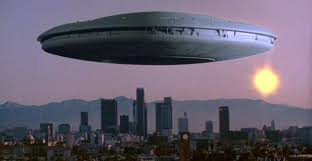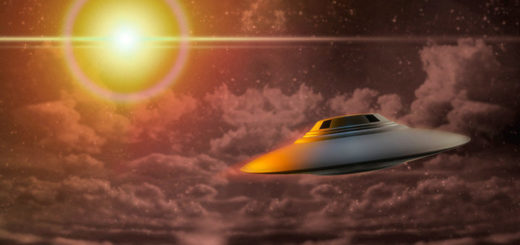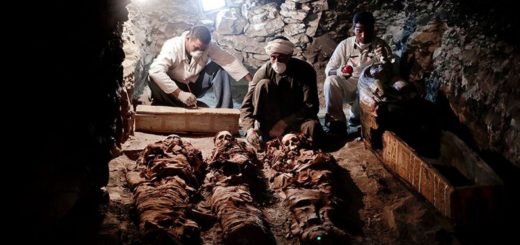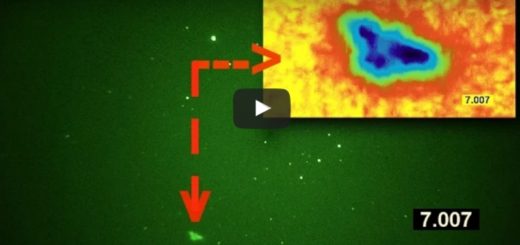Navy Aviators Encounter Three Silver, Disc-Shaped UFOs

Cosmic Curiosity: Naval History Magazine Reports on August, 1952 Incident
Cosmic Curiosity: by Commander Edward P. Stafford, US Navy (Retired)
Half a century ago, three Navy aviators saw something high above their Greenland base that baffled them.
It was August 1952. I was officer in charge of a detachment of three Navy patrol planes operating out of the new US air base at Thule, in northwest Greenland, some 80 miles from the North Pole.
The primary mission assigned our four engine, World War II Privateers was “ice reconnaissance.” That meant flying out over the Kennedy Channel, Smith Sound, Baffin Bay, and the Davis Strait and plotting the location of the pack ice and large bergs.
That data was relayed to the ships that each summer re- supplied the chain of arctic radar stations known as the DEW (distant early warning) line.
Our secondary job, not to interfere with ice reconnaissance, was to support a group of scientists conducting cosmic ray research. About once a week, when weather conditions were right, they sent up a huge, translucent “Skyhook” balloon with a package of sensative photographic plates sus- pended under it.
The balloons would drift downwind at an altitude of 90,000-100,000 feet, where the atmosphere (spun thinner near the poles by the rotation of the earth) was sufficiently attenuated to permit the cosmic rays to make their telltale traces on the photographic plates.
When the plates had been exposed for a few hours, the scientists would send a radio signal to the balloon, exploding a small charge, cutting the plates loose, and returning them to earth under a large, bright red parachute.
Our job was to fly above any overcast, keep the high balloons in sight, and report the landing location of the parachuted plates for recovery by helicopter.
The high-flying gas bags were equipped by low power, low frequency radio transmitters to which we would tune our radio compasses so their needles always pointed toward the balloons.
These were easy flights, always in good weather and always at an altitude safely above the tall, cloud-shrouded bergs and coastel rocks we often had to dodge on ice patrol.
Each of us had two or three of those “milk runs” while deployed to Thule, and we rather enjoyed the change of tactics and routine, as well as the virtuous feeling that we were helping to advance the cause of science.
This is why I was surprised to find one of the other plane commanders as tense and pale on return from a balloon chase as though it had been a hairy combat mission or a close encounter with a berg or a mountaintop.
Lt. John Callahan was a salty, steady professional pilot, so I knew when I saw him walking in from his plane that something serious had happened on that flight.
“What the hell’s the matter John?” I asked him. “You look as if you’d just survived a midair!” “Ed, you’re not going to be- lieve it. I’m not even sure I do… and I SAW it. And so did O’Flaherty and Merchant. At least most of it. And I don’t think they believe it either.”
I followed John into the line shack where he wrote up some minor gripes on his airplane, then into our little ready room where we poured ourselves coffees and sat down. John was not acting at all like the Callahan I knew.
Although he was an experienced and highly competent naval aviator, John Callahan’s normal manner was outgoing and cheerful, even jovial, with lots of smiles and laughter and banter… even after a low-level hurricane penetration or a long patrol in instru- ment weather. Not this day.
Now he was deadly serious and obviously shaken. The last time I had seen a man like this was in wartime.
Here is John Callahan’s story:
He was flying at 10,000 feet in the clear with the balloon in sight high above and the radio compass needle locked on to the balloon’s transmitter. Through the one set of binoculars carried in each aircraft, he and his copilot, Lt. (jg) Bill O’Flaherty, occasionally inspected the balloon and its instrument package, trailing beneath like the tail of a kite. Everything looked normal for most of the flight.
Then, on a routine check with the binoculars, John found something very abnormal about the balloon and its payload. He looked for a long time and then passed the glasses to O’Flaherty.
“Take a look at our target,” he told the young officer, “and tell me what you see.” O’Flaherty looked, lowered the glasses and glanced sharply at John, then looked again. “Well?” “Jesus Christ, John there are three bright silver discs attached to that instrument pod! They weren’t there the last time I looked. Where the hell did they come from?”
Callahan took the glasses back and looked again. They were still there exactly as the copilot had described, three shining, saucer-shaped metallic objects clustered on the hanging trail of the balloon just above the black dot of the science package.
On the intercom Callahan called the plane captain to the cock- pit and handed him the binoculars. “Take a look Merchant. What do you think?”
The captain’s reacton was the same as the copilot’s. “What the hell are they? Where did they come from?”
Callahan took the glasses back and studied the strange objects for several minutes while O’Flaherty maneuvered the Privateer to keep the target in sight. Suddenly Callahan sucked in his breath and held it.
What he was seeing could not be happen- ing. The three objects had detached themselves from the tail of the balloon and formed up into a compact vee.
As Callahan watched incredulously, they executed what looked at that dis tance like a vertical bank to the left and accelerated to a blinding speed that took them out of sight, climbing in about three seconds.
Callahan handed the glasses back to O’Flaherty. “They’re gone,” he said slowly, “CLIMBING from 90,000 feet. Never saw anything turn so tight or move so fast.”
Back in the ready room after the instrument pod had landed and its position had be reported, this was the aspect of the phenomenon that most affected Callahan.
“Jesus, Ed,” he told me, “from the angle of the sky those things passed through in the three seconds they were in sight, at that distance, they must have been going tens of thousands of miles an hour. They must have pulled a hundred Gs in that turn. And what the hell climbs out, ACCELERATING from 90,000 feet?”
John sat down that day, while it was still clear in his head, and wrote a full report of the incident. It went through the chain of command to the Office of Naval Intelligence. A report was also made to the Air Force authorities at Thule.
There never has been an explanation, nor even an acknowledgment of the report. The phenomenon exists today only in the memory of John C. Callahan, his copilot, his plane captain, and I, to whom it was told so vividly when it was fresh.
(Commander Stafford is the author of The Big E (1962) and Subchaser (1988) both published by the Naval Institute.)



 Creators of mankind
Creators of mankind Description of “Tall white aliens”
Description of “Tall white aliens” Where they came from?
Where they came from? About hostile civilizations
About hostile civilizations The war for the Earth
The war for the Earth “Tall white aliens” about eternal life
“Tall white aliens” about eternal life Video: “Nordic aliens”
Video: “Nordic aliens” Aliens
Aliens Alien encounters
Alien encounters The aliens base
The aliens base UFO
UFO Technology UFO
Technology UFO Underground civilization
Underground civilization Ancient alien artifacts
Ancient alien artifacts Military and UFO
Military and UFO Mysteries and hypotheses
Mysteries and hypotheses Scientific facts
Scientific facts


















